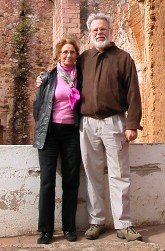 Main mound at La Venta from the plaza.
Main mound at La Venta from the plaza. At the top of the main mound, well above the trees with view to the horizon on all sides.
At the top of the main mound, well above the trees with view to the horizon on all sides.Chetumal is on the Caribbean, with a large bay. It too has grown in the years since we had our VW engine replaced. We spent the night and went on to Tulum the next morning.
On the way, we stopped at Bacalar where we had stayed while our VW was being fixed. We could not find the lab where we had stayed, but we did see the 1930s fort, built just after the end of the Caste War (which lasted from the late nineteenth century). The Maya turned out to be a bigger problem than the folks in Mexico City originally realized.
We got to Tulum in the evening. It became apparent that the area had been hit by hurricane Wilma, as the trees looked like they had been mowed off about 5 meters above the ground.
The town is a few kilometers from the beach. Christiane wanted to sleep to the sound of surf, so we stayed in a cabaña on the beach instead of a hotel in town. We had dinner in town before heading back for a beer at the bar at the cabañas. The electrical generator turns on at sundown, around 6:30, and lasts for two hours, then everyone just goes to bed. The bath was in a central building, cold water only; and I looked around carefully for scorpions when I got up to go to the john, just like my grandparents had told me to do.
The next morning, we packed up and headed to the site of Tulum before the buses from Cancun showed up. We just made it. The site is no longer as easy to reach as it was 30 years ago. Back then I body surfed up the beach and climbed the cliff to the site. Now you have to go in the main gate and stay on the paths, which is really a good thing with the numbers of tourists who come through everyday.
As the buses from Cancun showed up with their hoards of camera toting Americans, the rest of us left to visit other sites. We had read in our French guidebook to visit Tulum early in order to avoid the Cancun tourist buses, and curiously, nearly everyone else who showed up early was also French. They had to have used the same guidebook, Le Routard.
 Tulum was a Maya "port" catering to the extensive coastal canoe trade at the time of the conquest, and continuing for a few years afterwards. Three sides were protected by stone walls, and the fourth side by these cliffs. All the buildings are somewhat poorly constructed and about half-sized. It was the main such "port" city on the coast. It was reinhabited and became the capital of the Maya rebellion after Puerto Carrillo fell to Mexican forces in the early twentieth century during the Caste War.
Tulum was a Maya "port" catering to the extensive coastal canoe trade at the time of the conquest, and continuing for a few years afterwards. Three sides were protected by stone walls, and the fourth side by these cliffs. All the buildings are somewhat poorly constructed and about half-sized. It was the main such "port" city on the coast. It was reinhabited and became the capital of the Maya rebellion after Puerto Carrillo fell to Mexican forces in the early twentieth century during the Caste War. One of the better preserved temples with a plaster bas-relief of the upside-down god in the center tablero and found on several buildings in Tulum and in other sites such as Labna.
One of the better preserved temples with a plaster bas-relief of the upside-down god in the center tablero and found on several buildings in Tulum and in other sites such as Labna.We continued on to Puerto Morelos where Lilia has her cultural resources company, Empresa del Manejo Cultural, S.A., and checked in a the Hotel Inglaterra (probably not the best choice).













No comments:
Post a Comment